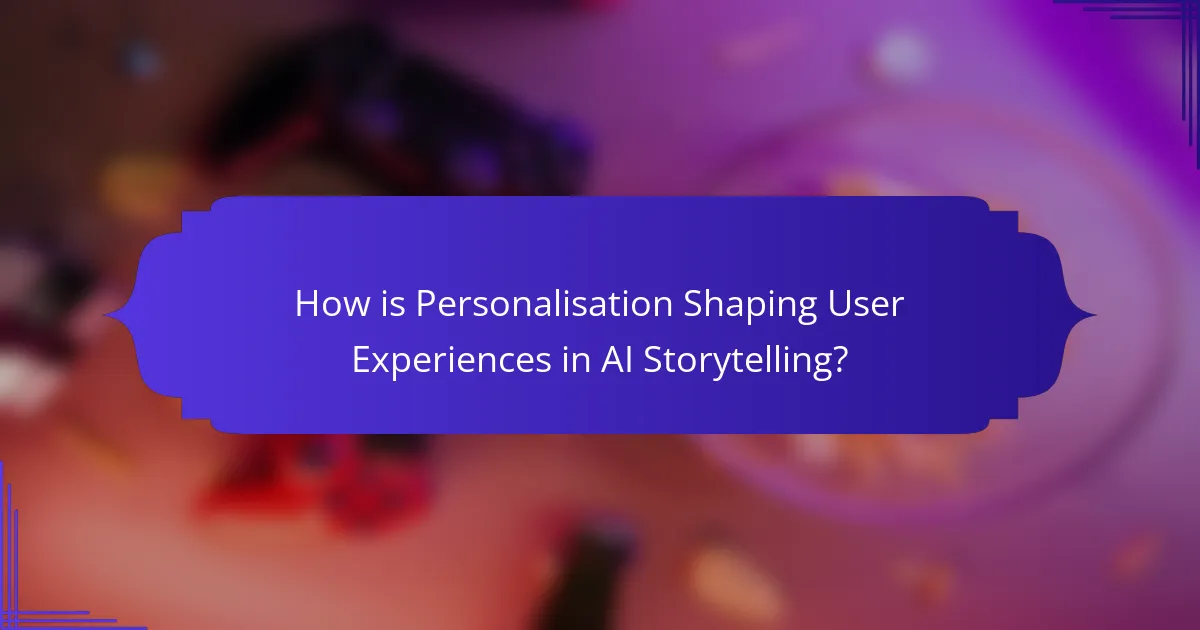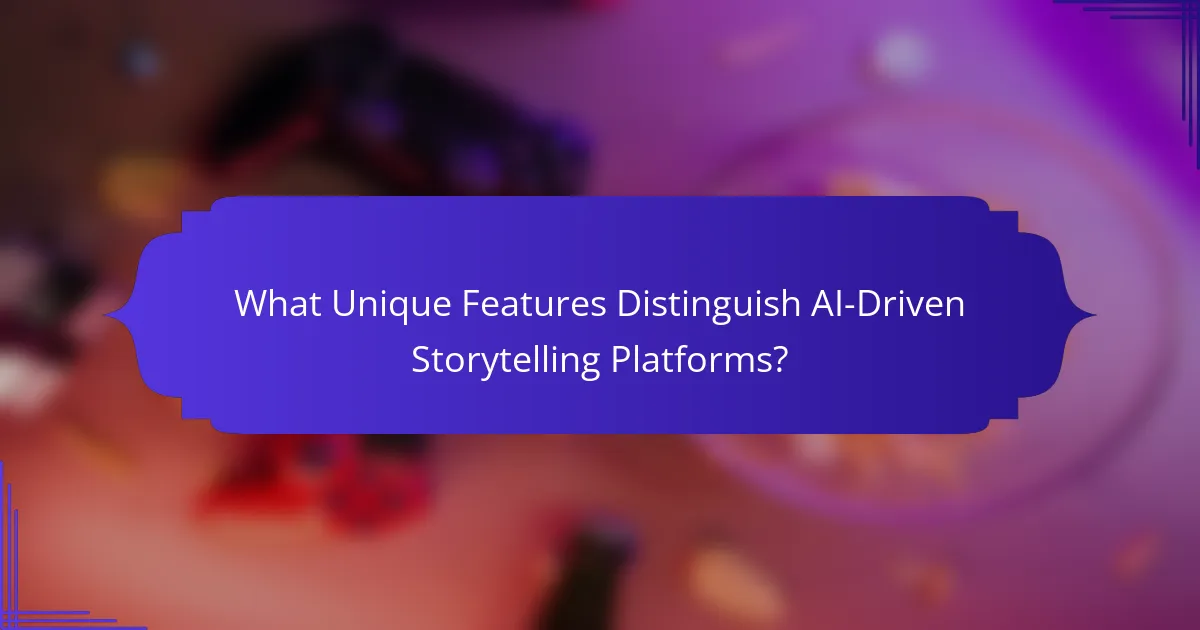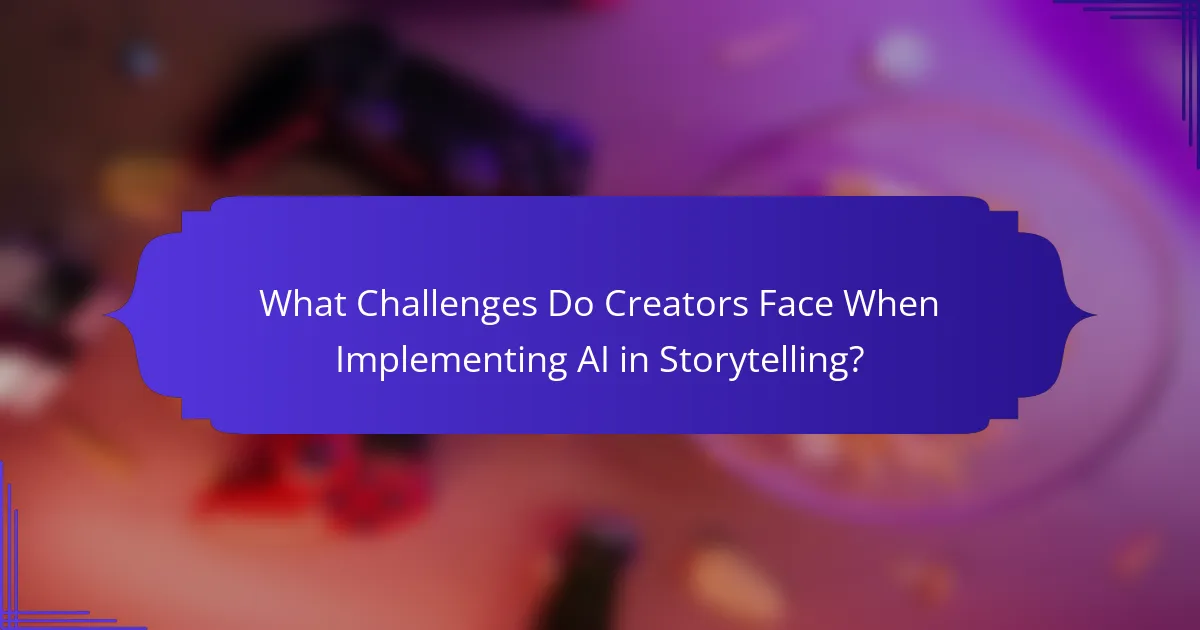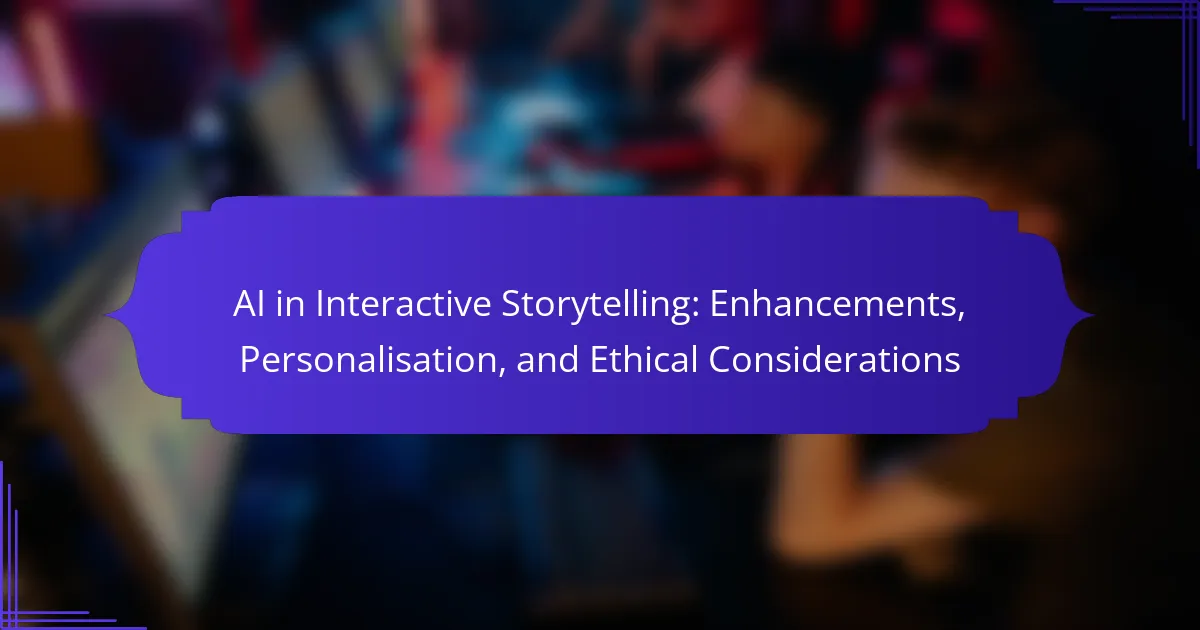AI is revolutionising interactive storytelling by enhancing user engagement, enabling personalised narratives, and introducing critical ethical considerations. It tailors experiences based on user preferences, fostering deeper emotional connections. The integration of AI raises questions about authorship and bias, challenging creators to maintain user agency and inclusivity. As technology evolves, addressing these aspects will be essential for responsible narrative development.

How is AI Enhancing Interactive Storytelling?
AI significantly enhances interactive storytelling by enabling personalised experiences, dynamic plot development, and ethical content creation. It analyses user choices and preferences to tailor narratives, ensuring engagement and immersion. Additionally, AI facilitates real-time adjustments to storylines based on audience feedback, creating a more interactive environment. Ethical considerations arise as creators must balance innovation with responsible content practices, ensuring that AI-generated narratives respect user agency and cultural sensitivities.
What technologies are driving AI advancements in storytelling?
AI advancements in storytelling are driven by natural language processing, machine learning, and neural networks. These technologies enable dynamic content generation, personalised narratives, and interactive experiences. For example, machine learning algorithms analyse user preferences to tailor storylines, enhancing engagement. Additionally, ethical considerations arise regarding bias in AI-generated content and the implications for authorship and creativity.
How does AI improve narrative complexity and engagement?
AI enhances narrative complexity and engagement by creating adaptive storylines that respond to user choices. It personalises experiences through data analysis, tailoring content to individual preferences. This dynamic interaction fosters deeper emotional connections and immersion. Additionally, AI can introduce unique plot twists and characters, enriching the storytelling landscape. Ethical considerations arise as creators balance innovation with user agency, ensuring respectful and inclusive narratives.
What are the key benefits of using AI in storytelling?
AI enhances storytelling by enabling personalisation, improving engagement, and facilitating ethical content creation. These benefits include tailored narratives based on user preferences, immersive experiences through interactive elements, and the ability to address bias and representation issues. AI-driven analytics provide insights into audience behaviour, allowing creators to refine their stories effectively. Additionally, automation reduces production time, enabling more frequent and diverse content generation.

How is Personalisation Shaping User Experiences in AI Storytelling?
Personalisation significantly enhances user experiences in AI storytelling by tailoring narratives to individual preferences. This customisation increases engagement and emotional connection. AI systems analyse user data to adapt storylines, characters, and outcomes, creating unique experiences. As a result, users feel more invested in the narrative, leading to higher satisfaction and retention rates.
What role does user data play in personalised storytelling?
User data is crucial for personalised storytelling as it tailors narratives to individual preferences. By analysing user interactions, AI enhances engagement through customised plotlines, character development, and thematic elements. This personalised approach increases emotional connection and improves user experience. Ethical considerations arise regarding data privacy and consent, necessitating transparent data usage practices.
How does AI adapt narratives based on user choices?
AI adapts narratives based on user choices by analysing interactions and preferences. It utilises algorithms to create personalised story arcs that respond to decisions, enhancing engagement. This adaptability allows for unique experiences tailored to individual users, making storytelling more immersive. The ethical considerations include ensuring user data privacy while maintaining narrative integrity.
Which personalisation strategies are most effective in storytelling?
Effective personalisation strategies in storytelling include user-driven content adaptation, dynamic character development, and context-aware narrative adjustments. These techniques enhance engagement by tailoring experiences to individual preferences and behaviours. For instance, AI can analyse user choices to modify plotlines, ensuring relevance and emotional connection. Additionally, leveraging data analytics allows storytellers to predict audience reactions and refine narratives accordingly. This approach fosters deeper immersion and satisfaction in interactive storytelling experiences.

What Ethical Considerations Arise from AI in Interactive Storytelling?
AI in interactive storytelling raises significant ethical considerations, including authorship, bias, and user agency. The integration of AI can blur the lines between creator and machine, leading to questions about ownership of narratives. Additionally, AI systems may perpetuate biases present in training data, affecting character representation and plot development. Ensuring user agency is crucial; players should feel their choices matter within the story. Developers must navigate these concerns to create responsible and inclusive interactive experiences.
How can bias in AI algorithms affect storytelling outcomes?
Bias in AI algorithms can significantly skew storytelling outcomes by reinforcing stereotypes and limiting diverse narratives. This bias arises from training data that may reflect societal prejudices, leading to unbalanced character development and plot progression. As a result, stories may lack authenticity and fail to resonate with a broader audience. Addressing bias is essential for creating inclusive and engaging interactive storytelling experiences.
What are the implications of user privacy in AI-driven narratives?
User privacy in AI-driven narratives is critical, as it influences trust and user engagement. Ensuring privacy fosters a safe environment for personalised storytelling. AI systems often collect data to enhance user experiences, but this raises ethical concerns about data usage. Transparency in data collection processes is essential to mitigate risks. Users should have control over their information, promoting responsible AI practices. Implementing robust privacy measures can enhance user confidence and satisfaction in interactive storytelling platforms.
How can creators ensure ethical practices in AI storytelling?
Creators can ensure ethical practices in AI storytelling by prioritising transparency, consent, and inclusivity. Transparency involves clearly communicating AI’s role in storytelling. Consent requires obtaining user permission for data use. Inclusivity ensures diverse representation in narratives.
Additionally, creators should regularly assess AI outputs for bias, ensuring fairness and respect for all audiences. Implementing guidelines that promote ethical standards can further enhance storytelling integrity. Engaging with community feedback can also help identify ethical concerns and improve practices.

What Unique Features Distinguish AI-Driven Storytelling Platforms?
AI-driven storytelling platforms are distinguished by their ability to personalise narratives, enhance user engagement, and address ethical considerations. Personalisation allows users to influence story outcomes based on preferences, creating a unique experience. Enhanced interactivity fosters deeper emotional connections through responsive storytelling. Ethical considerations ensure responsible AI usage, addressing biases and promoting inclusivity. These features collectively redefine narrative experiences in digital media.
Which platforms are leading in AI-enhanced storytelling?
Leading platforms in AI-enhanced storytelling include OpenAI’s ChatGPT, Google’s DeepMind, and Microsoft’s Azure AI. These platforms utilise advanced algorithms for personalisation and interactivity.
OpenAI’s ChatGPT excels in generating contextually relevant narratives, enhancing user engagement. Google’s DeepMind focuses on adaptive storytelling techniques, allowing for dynamic plot developments. Microsoft’s Azure AI integrates user data to tailor story experiences, promoting ethical considerations in content creation.
These platforms represent the forefront of innovation in AI-driven storytelling, significantly impacting how narratives are crafted and experienced.
How do unique narrative structures influence user engagement?
Unique narrative structures significantly enhance user engagement by providing immersive experiences tailored to individual preferences. These structures allow for adaptive storytelling, where user choices influence plot developments, creating a personalised journey. As a result, users feel more invested in the narrative, leading to increased emotional connection and satisfaction. Moreover, the integration of AI facilitates real-time adjustments to storylines, making interactions dynamic and responsive. This personalisation fosters a deeper engagement, as users explore diverse outcomes based on their decisions.

What Challenges Do Creators Face When Implementing AI in Storytelling?
Creators face several challenges when implementing AI in storytelling, including technical limitations, ethical concerns, and audience engagement. Technical limitations can hinder the integration of AI tools, affecting narrative coherence. Ethical concerns arise around data privacy and the potential for bias in AI-generated content. Additionally, creators must navigate audience expectations for personalisation while ensuring authenticity in storytelling. These challenges require careful consideration to balance innovation with responsibility.
What technical obstacles must be overcome for effective integration?
Effective integration of AI in interactive storytelling faces several technical obstacles. These include data quality, algorithm complexity, real-time processing, and user interface design.
Data quality is crucial; diverse and rich datasets enhance personalisation but are often hard to obtain. Algorithm complexity can hinder seamless integration, as advanced models require significant computational resources. Real-time processing is necessary for interactive experiences, demanding efficient systems that can handle dynamic inputs. Lastly, user interface design must facilitate intuitive interactions, ensuring users engage with AI-enhanced narratives effectively.
How can creators balance creativity with algorithmic constraints?
Creators can balance creativity with algorithmic constraints by leveraging AI tools for personalisation while maintaining artistic integrity. AI can analyse audience preferences, enabling creators to tailor narratives that resonate with viewers. This approach allows for innovative storytelling that adheres to algorithmic guidelines without sacrificing originality. Additionally, understanding platform algorithms helps creators optimise content distribution, ensuring their work reaches the intended audience effectively. Engaging with community feedback further enriches the creative process, fostering a dialogue that informs future projects.

What Future Trends Can We Expect in AI and Interactive Storytelling?
AI is transforming interactive storytelling through enhanced engagement, personalised narratives, and ethical considerations. Future trends include advanced algorithms for adaptive storylines, user-driven content customisation, and increased focus on responsible AI use. These developments will elevate user experiences while addressing potential biases and privacy concerns. The integration of machine learning will allow for real-time adjustments based on user interactions, creating a more immersive environment. As storytelling becomes more interactive, ethical frameworks will guide creators in ensuring fairness and inclusivity in narratives.
How will advancements in AI technology shape storytelling formats?
Advancements in AI technology will significantly enhance storytelling formats by enabling interactive and personalised experiences. AI can analyse user preferences to tailor narratives, creating unique story arcs for each individual. This personalisation fosters deeper engagement and emotional connection with the content. Additionally, ethical considerations arise as creators must balance innovation with issues of bias and representation in AI-generated narratives. The integration of AI in storytelling is reshaping how audiences interact with stories, making them more immersive and relevant.
What emerging trends are influencing user expectations in storytelling?
AI is transforming user expectations in storytelling by enhancing interactivity, personalisation, and addressing ethical considerations. Users increasingly demand immersive experiences tailored to their preferences.
Emerging trends include adaptive narratives that respond to user choices, AI-generated content that aligns with individual tastes, and transparency regarding data usage. These factors shape how stories are created and consumed, reflecting a shift towards user-centric storytelling.
Furthermore, ethical considerations around bias and representation are becoming critical. As AI tools evolve, creators must ensure diverse perspectives are included, fostering a more inclusive storytelling landscape. This focus on ethics will likely influence future user expectations significantly.
What best practices can storytellers adopt for successful AI integration?
Storytellers can adopt several best practices for successful AI integration. First, they should prioritise audience engagement through personalised content. Utilising AI tools can analyse user preferences, allowing for tailored narratives that resonate with individual experiences.
Second, ethical considerations must guide AI use. Storytellers should ensure transparency about AI-generated content, maintaining trust with the audience. Implementing guidelines for responsible AI deployment can enhance storytelling integrity.
Third, collaboration with AI developers is vital. Storytellers can provide insights into narrative structure, ensuring AI tools align with creative goals. This partnership can lead to innovative storytelling techniques.
Finally, continuous learning is essential. Staying updated on AI advancements enables storytellers to leverage new capabilities, enhancing their craft while adapting to evolving audience expectations.
